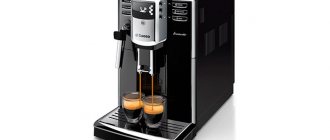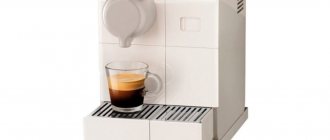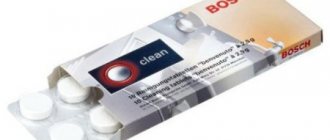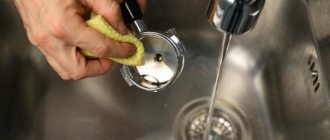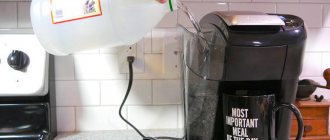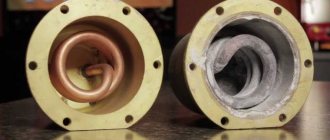Descaling your Nespresso coffee machine
Hard water is an everyday reality in our homes.
Therefore, it is enough to neglect cleaning the Nespresso for a short time in order to then deal with a thick layer of scale on its parts. After all, some minerals, such as calcium and magnesium, affect the formation of scale when exposed to temperatures above 550C. Calcified deposits not only affect the taste of the coffee, but also significantly reduce the performance of the machine. However, there are many home remedies that will magically help remove plaque.
To ensure that your equipment always works properly, it is useful to know how to descale your Nespresso coffee machine at home.
What type of coffee does Vertuo prepare (drinks and capsule review)
So, the “old” Nespresso Original still makes espresso and lungo, although consumers torture them en masse, trying to make large-volume coffee like Americano, although it is not made that way at all. And this, by the way, is the main task, and at the same time the main trump card of the new Vertuo system - to prepare digestible coffee in large mugs.
But this is not espresso. And not Americano (filter coffee). As is clear from the review of the internals and operating principle of Nespresso Vertuo, this is, dare I say it, a new way of brewing coffee. It is relatively weak and unsaturated, but it reveals the taste in large volumes.
I can't find any other option, even among alternative cooking methods, that would come close to it. And this is neither good nor bad. Just a new way. After all, the Aeropress was also invented not so long ago, and espresso in its modern form is no more than 60-70 years old.
Of course, Nespresso left four flavors that are declared as espresso (Diavollito, Altissio, Voltesso and decaffeinated Decaffeinato Intenso). Volume - 40 ml with a recommended retail price (RRP) from 36 rubles per capsule. But the drink is completely different. Especially in the example of espresso, it is clearly noticeable that the cream foam here is completely different. And this is not without reason - the centrifuge creates an effect very similar to that used in Philips Latte Go automatic cappuccino makers (just compare the photo of it and the silicone ring above), but not for milk, but for coffee. That is, the coffee whips up a little during brewing, which is why it gets such an unnatural foam structure for espresso. I would compare it to foam on raf coffee:
This is not a cream. This is creamy coffee - that's more accurate. Photo: expertreviews.co.uk
Three more coffees are sharpened to a volume of 80 ml and are declared as “Double Espresso” , although such a drink still cannot be any variant of espresso due to the brewing method. Capsules of this volume are already larger in shape and in price - RRP 41 rubles in the official Nespresso store (at the time of writing the review):
Barista Creations Bianco Leggero (cream with gradient) Chiaro (brown-golden capsule) Scuro (Dark brown)
Gran Lungo (150 ml) has an RRP of 42 rubles and the same physical capsule size as double espresso. Four blends are presented on the Russian market. However, Nespresso has unified their range as much as possible, so that in the States, in Europe, and in Australia, the same set of capsules for large lungos is presented. There are slight differences in the assortment for the most “voluminous” flavors (of course, there are more of them in America) and, conversely, for espresso - in Europe there is one more.
But let's return to Grand Lungo, here's what we have:
Grey-green Fortado. Arabica from Colombia + Robusta from India. Gray Arondio. Arabica from Colombia + robusta from Guatemala. Pink pastel Aflorazio. Arabica from Ethiopia. Rose red Decaffeinato Ontuoso. Another decaf.
Basic variety of flavors for a large 230 ml cup. I won’t list them all, look for yourself on the official Nespresso Club website. Let me just note that the RRP starts from 48 rubles, and such a wide selection of drinks is due to the fact that this volume is the main one for the Vertuo system, its trump card. It is here that all the advantages described above appear. Because no ordinary Nerspresso capsule could squeeze out more than 200 ml, not to mention the fact that due to the pressure at such volumes it turns out to be a completely non-drinkable mess.
And there are also giants with 414 ml. In Russia there are only two flavors (Alto Intenso and Alto Dolce) for 59 rubles each, but these are larger capsules for Americans, as even the volume hints at - 414 ml was obtained because it was initially measured in fluid ounces. 14 fl oz is the US standard for a large cup. Even knowing the love of our compatriots for coffee as a snack with a sandwich, I am sure that here, as in the rest of Europe, this format will not be popular.
After all, what kind of coffee can you brew using 13-odd grams of coffee and almost half a liter of water?
Yes, it's time to write about grammar.
How much coffee in grams are in Nespresso Vertuo capsules and what is inside?
This depends on both the size of the capsule and the specific blend. Since the Vertuo brewing technology does not involve pressing the coffee and it is not necessary to fill the capsules tightly (on the contrary, water should pass freely through the ground coffee), the gram capacity is actually less than what could be filled to capacity even for the smallest espresso capsules. Shake them in the store - they are all like a rattle and have different weights.
That is, the strength is regulated not only by the type of coffee and the amount of water, but also by the mass of ground coffee inside the aluminum foil. This is the minimum I found - 5.5 grams for the Voltesso blend. Which is logical, it is declared as the mildest, weakest taste among the “small” recipes.
- The remaining espresso capsules (40 ml) are 7.5 grams , which is the standard for home espresso coffee makers. But I repeat, do not expect from Vertuo the same espresso as in a carob coffee maker or machine, Vertuo is about something else, it is about large volumes of weak coffee without over-extraction.
- 80 ml capsules contain approximately 11 grams of coffee. But I didn’t weigh everything, as in the case of single espresso, deviations are possible depending on the specific blend.
- 230 ml and half-liter XL capsules are approximately 13.2-13.3 grams each. Again, I haven’t weighed everything, deviations are possible for some limited editions.
Everywhere above is net weight. I forgot to weigh the large capsules, but there is a photo of the preparation of an espresso capsule:
7.5 grams. For the sake of experiment, I tried to brew the coffee in a carob coffee maker. It tastes like the dust of Polish soil. But this was expected - on the official website it is stated that this is a mixture of Arabica and African Robusta.
This blend's coffee is ground at the lower end of the espresso grind. Something between a Turk and a double-basket grinder for a professional coffee maker. Closer to the last one.
Dairy drinks: does Vertuo make cappuccino, latte, raff?
Yes and no. Let me explain. On the one side:
- As we have already found out, you cannot get espresso from the new capsule format. Therefore, strictly speaking, cappuccino cannot be made by definition, because the basis of this drink is espresso.
- Nespresso understands this, which is why the VertuoLine model line of capsule coffee makers does not include models with a milk jug-cappuccino maker at all, as was implemented, for example, in the Delonghi Latissima EN550.
- You can, of course, purchase a separate milk frother/cup. But, again, there is little point in trying to make cappuccino without espresso. Coffee with milk is fine. Moreover, coffee, not milk, will be responsible for the foam here.
On the other side:
- The very airy, dispersed (coffee + air bubbles) structure of the coffee that Vertuo dispenses allows you to quite effectively mix the coffee with what you previously poured into the cup.
- Actually, this is exactly how Nespresso offers to prepare milk-coffee treats and even produces special coffee blends “for milk.” Just pour milk or cream into a glass, place the glass under the coffee maker and make coffee. The stream of coffee actually mixes quite effectively with the milk, including some separation into layers like a latte macchiato.
The photo is not mine, but newlyswissed.com. But as you already understand, coffee on Vertuo always turns out identical. Capsules and coffee makers are all unified following the example of other capsule systems.
But I will go further and say that the Nespresso is probably better than other home coffee makers/coffee machines for raf coffee.
For those who don’t know, raf coffee is a purely Russian invention. Outside our homeland, the only people who have heard anything about him are baristas in popular resorts among Russians like Montenegro.
Therefore, at the Nespresso head office, neither the company’s marketers nor George Clooney personally thought of making a capsule with a recipe for raf. But in vain. After all, by pouring and mixing milk/cream with the desired syrup in a cup, and then adding this creamy coffee there, you will get a result that is as similar as possible to raff from a coffee shop. I will say more, the best way to make it at home is to use a carob coffee maker, and then use it to scrub the caked-on sugar off the pannarello. You cannot froth milk with additives in automatic coffee machines with a cappuccino maker. Well, that is, you can, but you need to clean it right away and it’s more difficult than a steamer/panarello.
Why deal with sediment?
Nespresso maintenance is a necessary step that every coffee machine owner should remember. To ensure excellent coffee quality, the equipment parts should be descaled from time to time.
If you use water filters, the cleaning procedure can be carried out less frequently.
Limescale on the coffee machine:
- significantly increases operating costs;
- may lead to premature failures;
- reduces heat transfer and causes problems related to drink temperature;
- causes aesthetic problems in coffee (the appearance of white flakes);
- activates valve leakage;
- reduces interaction with ingredients, negatively affecting their taste.
By constantly cleaning your Nespresso, you can
- save energy consumption;
- anticipate disruptions to work;
- maintain the appearance of drinks;
- ensure consistent quality of brewed coffee.
What can pollution lead to?
Equipment owners have many questions regarding equipment care:
- How to clean your Nespresso coffee machine?
- How to descale a Nespresso coffee machine?
The stages of cleaning the device can be found in the Nespresso descaling instructions.
Descaling your Nespresso coffee machine involves cleaning the tray, emptying the capsule container and replacing the water.
Note! Timely removal of deposits within 3 months ensures a full cleaning cycle and allows you to maintain the device in working condition throughout the entire period of operation.
Nespresso technical service is a necessary step in maintaining equipment in working condition. To ensure the proper quality of the drink, the equipment should be cleaned from time to time to remove deposits.
Important. When using filtered water to make coffee, the cleaning procedure is carried out less frequently.
With the formation of flakes and deposits on the walls of the machine, the quality of the prepared drink deteriorates:
- A musty smell appears;
- The prepared drink does not convey the aroma of real coffee;
- Impurities from scale have entered;
The resulting deposits and untimely cleaning lead to:
- Increased energy consumption for preparing the drink;
- Premature equipment failures;
- Reduces heat transfer, causing problems with the temperature of the prepared drink;
- Deteriorates the aesthetic component of the drink: the appearance of scale flakes;
- Leaking valves;
- Reduces the degree of interaction with ingredients and has a negative impact on the quality of the drink.
Important! Keeping your coffee machine clean will allow you to enjoy real coffee and also extend the life of the product.
Continuous cleaning of equipment:
- Energy saving;
- Problem prevention;
- Aesthetics of appearance;
- Stable quality of the prepared drink.
Which acid to choose
The ideal solution in the fight against calcified formations on the walls of the coffee machine is vinegar. It contains acetic acid, which is a weak organic acid.
The substance can treat internal surfaces even with a minimum volume. Appropriate amounts of vinegar should be applied depending on the degree of contamination of the stone.
Vinegar is a natural and toxic waste-free product. Its acidic properties help get rid of scale, mineral deposits and even the coffee oil left behind from the beans. Citric acid also helps in the fight against scale.
In other cases, special chemicals that are sold in stores and supplied in liquid or crystalline form will help. They most often contain organic sulfamic acid, which is an excellent product for a coffee machine and much safer for various types of metals.
Many acids that are used to combat plaque can sometimes have negative effects on the skin if you are not careful. Therefore, rubber gloves should be used when cleaning the coffee machine.
Most Nespresso models have programmed cleaning processes to remove scale. In this case, you should simply use cleaning products and select the appropriate button on the machine, which will start the process. If there is no such program, descaling the Nespresso coffee machine is carried out using available means.
The procedure consists of the following steps: filling the reservoir with water with the addition of a certain cleaning agent. Then you should turn on the coffee machine to brew coffee so that the liquid passes through all the working elements of the equipment, cleaning them from deposits.
Details on how to descale a Nespresso Citiz capsule coffee machine (video):
How to clean your Nespresso coffee machine
Nespresso machine seem to work as well as it used to? the coffee come out watery and without foam? Or worse...tastes weird? Any of these symptoms mean that your coffee machine urgently needs a thorough cleaning . It is not enough to wash it with water and it is not recommended to use dish soap as it may change the aroma and taste of the coffee. If you want to know how to clean Nespresso coffee machines , be sure to read this article and follow the steps we have provided.
How to descale Nespresso
The process of cleaning calcified deposits from a coffee machine is divided into two stages:
- Cleaning removable parts from dirt - wash all parts of the machine with warm water or wipe with a damp sponge.
- Descaling – Use active reagents to remove deposits from the water tank.
Such simple steps will not only help to wash away plaque, but will also cover parts of the coffee machine with a protective layer, which will prevent the formation of oils and coffee residues, as well as deposits of calcium salts for a long time, which will significantly increase the service life of kitchen equipment.
Remove scale with vinegar
What you will need:
- coffee machine;
- water;
- table vinegar;
- hot water;
- sponge;
- dry towel.
Nespresso descaling instructions:
- Drain the reservoir, rinse it and clean out any coffee grounds that remain in the filter.
- Make a solution of water and vinegar - fill the chamber to full volume with equal parts of water and acetic acid.
- Run half of the brew cycle. Turn off the coffee machine and leave it for an hour.
- Finish the brewing cycle - after an hour, turn on the equipment and finish the cycle.
- Discard the vinegar liquid and run a new cycle with clean water. Repeat twice to get rid of any remaining vinegar.
- Wipe down the appliance and wash tanks and other removable containers in hot soapy water.
- Put the car back together and make yourself a big cup of coffee!
Cleaning a delonghi coffee machine involves approximately the same steps.
Cleaning plaque with citric acid
The process of cleaning a coffee machine with citric acid is the same as when using vinegar. We take the amount of the ingredient in the ratio of 2 teaspoons of powder per 1 liter of water.
How to descale a Delonghi Nespresso coffee machine using official instructions
The manufacturer's instructions for Delonghi Nespresso recommend removing calcium deposits at least once every 3 months, or after using three hundred standard capsules. Some models are equipped with a built-in indication that notifies you of the need to perform the appropriate procedure. The most modern technology performs its functions with the connection of the application. It is downloaded to a smartphone or other mobile device, taking into account the operating system. Such software generates reminders automatically.
It should be emphasized that all of the above methods are characterized by low accuracy. The optimal interval between cleaning a Nespresso coffee machine from scale changes significantly with increasing/decreasing actual water hardness. The figures given in the instructions correspond to the European average. However, the following table clearly demonstrates the significant differences between the current standards:
| Level | Hardness range in mEq/liter | ||
| Russia | Germany | USA | |
| Soft water | 0-4 | 0-1,6 | <1,2 |
| Tough | 7-12 | 3,6-6 | 2,4-3,6 |
| Very tough | > 12 | > 6 | >3.6 |
Even the most expensive, well-equipped Delonghi Nespresso coffee machine models are not able to determine the actual level of hardness. They, as well as specialized applications, generate notifications according to a time schedule. To increase accuracy, you need to use specialized test strips or submit a water sample for laboratory analysis. In the simplest version, cleaning is carried out after the appearance of a characteristic coating on visible surfaces. However, the latter method increases the risk of excessive contamination of surfaces hidden from visual inspection.
Below is an algorithm for cleaning a Delonghi Nespresso coffee machine from scale from the standard official instructions:
- Remove capsules from the removable container and moisture from the drip container. These structural elements are returned to their original places.
- Activate cleaning mode. Taking into account the features of a particular model, press from 1 to 3 buttons simultaneously, or select the desired item in the menu on the display.
- The solution prepared in advance is poured into the working tank. Recommended descaling products Delonghi ecodecalk 500ml are purchased from a certified retailer of this brand.
- As a rule, the mixture is diluted with water in a one to one ratio. The lid of the container is closed. A large bowl is placed under the dispensing spout, which can hold the entire amount of technical liquid.
- Press the button that activates the work cycle. The instructions on the front panel are illuminated in flashing mode to prevent erroneous user actions. The equipment will perform the washing itself.
- After completing the first cycle, the liquid is poured from the storage container back into the main reservoir. Repeat the washing procedure.
- At the next stage, the spent solution with impurities is removed into the sewer. Disconnect and wash the drip collection device, main reservoir and pan holder. After completing the capsule descaling and drying of the Nespresso coffee machine, install the parts back.
- Fill in clean water and perform another work cycle with it. To activate, use the illuminated key. Repeat the procedure!
- At the final stage, they exit the service mode. To do this, press the necessary buttons at the same time, use the corresponding items in the menu.
Before brewing a hot drink after cleaning the Delonghi Nespresso coffee machine from scale, it is recommended to wait about 10-15 minutes.
Traditional methods: citric acid
Using improvised means is not only more convenient. This option involves the use of less expensive ingredients than “branded” drugs. A positive factor is the absence of potent substances that can destroy equipment and harm human health.
Citric acid is often offered as a cheap calcium remover. If you purchase it in granules, 15 g for every 500 ml of solution will be enough. The procedure is performed according to a standard algorithm, which is discussed in detail in the previous section of the article. You will have to increase the number of cleanings up to 3-4 times to get a good result. Use at least two washes with clean water to completely eliminate the characteristic odor.
Instead of citric acid, you can use table vinegar. The usual essence, not a concentrated solution, is diluted with the same amount of clean water and poured into the container of the coffee machine. A product based on soda and salt is also used. Optimal proportions are selected experimentally.
How to clean a Nespresso coffee machine: how often to carry out the procedure, with what means
Cleaning the delonghi nespresso capsule or carob coffee machine according to the instructions should be carried out regularly. Depending on the hardness of the water used, the event can be carried out once every 3 months or more often. If these recommendations are ignored, the owner will lose the right to warranty service, since salt deposits in technologically important components lead to breakdown of the coffee machine.
Cleaning your capsule coffee machine | How often to service?
Taking care of your capsule coffee machine is essential to ensure that your coffee drinking experience is always enjoyable: in fact, the cleanliness of your coffee machine also determines whether your coffee tastes good or not.
After drinking a cup of this favorite drink, you certainly don't want it to leave a bad taste in your mouth. Sometimes it only takes a few steps to make sure your coffee is always at its best, so be sure to follow these steps a few times a year.
There are several reasons why it is necessary to clean coffee machines for various purposes.
Cleaning the capsule coffee machine. Coffee oils
A capsule coffee machine is a comfortable option for making coffee at home and at work. Just insert the coffee capsule and your coffee is ready! But not everyone knows that capsule coffee machines also become dirty over time and also need to be cleaned. During the coffee preparation process, coffee residues are always formed in the form of oil deposits, since coffee contains coffee oils. The accumulation of deposits results in an unpleasant aftertaste in coffee. The longer the coffee machine is used, the more noticeable the unpleasant rancid taste becomes. Even the most delicious coffee can become bitter and unpleasant if you do not clean the coffee machine for a long time. To avoid these unpleasant taste sensations, it is important to regularly clean the inside of the capsule coffee machine from coffee deposits. Experts have provided a solution to this problem by developing special cleansing capsules. Check the standard of the cleaning capsule! The capsule standard must match the standard of your capsule coffee machine. The simple and easy use of such capsules allows you to quickly clean the coffee machine and continue to enjoy delicious coffee. This is why you need to clean your capsule coffee machine from coffee oils. But that is not all..
Cleaning the capsule coffee machine. Scale formation on heaters
A capsule coffee machine has a heating element that heats the water to prepare coffee. As you know, when water is heated, the walls of the internal parts of the coffee machine become covered with lime deposits. If this deposit is not cleaned, then over time it completely covers the walls of the heaters and their temperature decreases significantly. The temperature in the coffee machine will not be sufficient to prepare coffee. As a result, such a coffee machine will prepare warm and tasteless, “liquid” coffee. And with further use of such a coffee machine, its breakdown is possible. For stable and proper operation, the coffee machine requires regular descaling. This function is usually called decalcification. To solve this problem, special means are provided for descaling in capsule coffee machines. Convenient and simple use of these tools allows you to avoid the appearance of unstable coffee taste and prevent breakdown of the coffee machine. The principle of descaling is as follows: instead of water, a solution of water and descaling agent is poured into the coffee machine. This solution dissolves limescale deposits in the coffee machine. After using the product, the coffee machine must be rinsed with clean water and you can continue to prepare delicious coffee. The regularity of decalcification depends on the hardness of the water used. This is the reason why you should descale your capsule coffee machine. On average, decalcification of a capsule coffee machine is carried out once a month at a water hardness of 5 – 10 Dh. (European indicator deutsche Härte). Example instructions: decalcification of a Nespresso capsule coffee machine.
Cleaning the capsule coffee machine. Milk residues in hard-to-reach places of the cappuccino maker
Many capsule coffee machines have a cappuccino function. Someone may have a question, why clean a capsule coffee machine from milk residues when you can simply rinse it with water? We'll tell you... Coffee machines with a cappuccino function usually use natural milk. Natural milk contains fats that settle in the tubes and on the inner walls of the cappuccino maker. It is very important to completely remove milk residues, as even a small amount can turn into dangerous bacteria in just a couple of hours. In this case, there is an option to manually wash the cappuccino maker yourself. For the best result in cleansing milk and milk fats, a special product has been developed. With its help, fats are dissolved, and milk residues are washed out even from the most inaccessible places of the cappuccino maker. The cleaning principle is simple: instead of milk, a solution of water and a special product for cleaning the milk system is poured into the cappuccino maker. The machine is washed with a solution. After this, you need to rinse the cappuccino system with clean water and the machine is ready to prepare a delicious cappuccino for you again!
The result is not one, but even three types of coffee machine cleaning:
- Cleaning from coffee oils - every 30 - 40 capsules
- Descaling – once a month
- Rinsing the cappuccino maker - daily
In the near future, information on servicing coffee equipment will be available in a special section
Instructions for cleaning coffee machines
You might be interested:
How to decalcify a Dr. coffee machine. Coffee?
Decalcification of a capsule coffee machine
Cleaning products for coffee machines
Dr. Purity
Selecting cleaning products
There are several ways to clean a Nespresso capsule or carob coffee machine. For this purpose, you can purchase the original Delonghi Ecodecalk liquid of 500 ml. The quantity is enough for 4 – 5 uses, since the solution is concentrated. The composition includes several acids:
- lemon;
- maleic – a derivative of malic acid, a safe substance for health;
- phosphonic - prevents the rapid appearance of new sediment on the walls of parts.
All components are selected and designed in such a way that after the final rinsing, no harmful substances are detected in the coffee, and the walls of the tubes and main parts are not damaged by chemicals.
If you use improvised means, it will cost less. True, the complete cleaning cycle will have to be repeated 3–4 times to completely remove scale. Use citric acid or vinegar in diluted form.
If there is no specialized product for decalcifying a Nespresso coffee machine in the store, according to the instructions, you can use other products, for example, intended for other brands of machines.
How often should you wash your car?
Nespresso should be cleaned at least once every three months. If you do not brew coffee often, then you can focus on the number of servings made - the norm is 300 pieces, after which the machine is washed.
It is recommended to test the water for the presence of salts. The following may be present in dissolved form in tap liquid:
- Iron salts. The color of the deposits will have a reddish tint.
- Magnesium and calcium salts.
- Ions of other metals, such as aluminum.
- Gases.
When heated, they form hard, porous deposits that interfere with the normal operation of the device.
Distilled water contains no impurities, making it an ideal liquid for coffee machines. If you have a built-in reverse osmosis filter at home, it is recommended to use such water to fill the coffee maker container.
If you use tap liquid, cleaning will have to be done more often. How often can be determined by the scale in the kettle. If a thick layer accumulates on the inner walls within a month, then the coffee maker needs to be cleaned twice a month.
If you calculate the costs of bottled water and compare them with the purchase of professional descalers, then it will be cheaper to buy water in a store.
Cleaning the capsule coffee maker from scale
If you have a capsule coffee maker like a Nespresso, there are only four things you need to do to get consistently good coffee, quickly and without any problems.
1. Fill with clean and soft water.
2. Buy capsules with good coffee, freshly roasted.
3. Keep the outside of the coffee maker clean.
4. Keep the inside of the coffee maker clean.
If everything is simple and clear with the first three points, then questions arise with the fourth.
Most of us have seen limescale in a kettle, but it also exists in coffee makers, where there are thin tubes that clog easily.
Cleaning them with citric acid or vinegar is dangerous. These substances can damage the rubber parts of the coffee maker, which in turn will void the warranty. It is better to use special descalers for espresso coffee makers; they are more expensive, but they will not damage anything. One half-liter bottle is enough for 5-6 uses.
If you use reverse osmosis water, you still need to clean it, it just can be done for preventive purposes and much less often.
Cleaning kit from the manufacturer
The manufacturer has specially developed chemicals for cleaning Nespresso krups coffee machines and other types of capsule or carob units. For built-in cappuccino makers, additional liquids or tablets are available to remove residual milk fat from the walls of the container and the conductive tubes.
There is a separate liquid from the oily residue that forms in the cooking group, but most often two ingredients are combined in one product, simultaneously cleaning all contaminants.
Step-by-step instructions for nespresso descaling
Instructions for cleaning Nespresso Delonghi capsule and regular:
- Remove grounds from the waste container or used capsules and clean the drip tray.
- Prepare a solution of descaling agent as written in the manual.
- Pour it into the water container and start the cleaning mode. Place a cup under the spout that can hold the entire amount of liquid from the reservoir.
- After the first cleaning cycle, some manufacturers recommend pouring the cleaning solution back into the reservoir and starting the process again.
- Pour the used liquid into the toilet.
- Pour clean water into the container and rinse the system once. When using original cleaning solutions, once is enough.
Next, you should rinse the pan and water tank under the tap and install them in place. If there is a remote milk jug, it is washed under the tap; if there is a built-in cappuccino maker, it is washed along with the entire device with chemicals and then with clean liquid.
How to properly rinse the cappuccino maker of a capsule coffee machine
If the capsule coffee machine is intended not only for making espresso and Americano, but also prepares drinks with milk, then in addition to general cleaning, do not forget about the cappuccino maker. It can be stand-alone or built-in.
In any case, it is worth washing it after each use. The autonomous cappuccino maker is washed like regular dirty dishes - in soapy water using a soft cloth or sponge. To thoroughly rinse the built-in cappuccino maker, you need to lower its tube into the washing solution and run it several times. Then repeat the same steps 2-3 times with plain water to wash off any remaining detergent.
Reliable ways to clean a Nespresso coffee machine with your own hands
The bitter-tasty smell of coffee seems to fill you with cheerfulness and paint your gray everyday life in joyful colors.
Nowadays, preparing a drink, thanks to the advent of special devices - coffee machines, requires minimal effort: just pour in ground beans or load a special capsule into the device - and in a few minutes a cup of hot aromatic liquid is in your hands.
As in other devices that come into contact with water during operation, scale forms on the elements of the coffee machine over time, which must be periodically removed.
Why deal with sediment?
Maintenance is a necessary rule for caring for any household appliance.
IMPORTANT! To remove lime deposits that form as a result of hardness salts settling on the heating elements of the device, equipment parts should be descaled at regular intervals.
Ignoring the procedure leads to malfunction of the unit:
- plaque on the heating element impairs the heat exchange between the surface of this part and water, causing an increase in energy consumption during operation of the device and a decrease in the quality of brewed coffee;
- the finished drink may contain scale particles and white flakes;
- there is a risk of valve leakage, which, in turn, can lead to premature failure of the machine.
How often should the procedure be performed?
Manufacturers of coffee machines recommend cleaning the devices from calcified deposits after every 250-300 cups of drink prepared by the machine.
Modern models of devices are equipped with a special sensor, thanks to which you can easily navigate when to start cleaning.
If your device is not equipped with such a device, the following signs will indicate the need for descaling:
- the process of equipment operation is accompanied by additional noise, which is absent provided the device operates in normal mode;
- the finished drink comes out in a thin stream.
ATTENTION! Also, the frequency of cleaning directly depends on the hardness of the liquid you use for cooking.
Characteristics of water that help maintain the functionality of the machine and allow you to get delicious coffee:
| Physical and chemical properties | Optimal value |
| Color | Lack of color, transparency |
| Smell | No smell |
| Chlorine | 0 mg/l |
| General mineralization | 150 mg/l |
| Total concentration of alkaline compounds) | 40 mg/l |
| pH | 6,5-7,5 |
| Calcium hardness | 51-68 mg/l |
| Sodium content | less than 30 ml/l |
ATTENTION! Clean the tray, change the water and empty the capsule reservoir after each use of the equipment. Descaling should be done at least once every 3 months.
Standard method: hand wash
Regular washing of the device elements allows you to keep the device clean and contributes to slower scale formation.
Carry out the procedure once every 14 days in the following sequence:
- remove the tray from the appliance and wash it with soapy water (using a mild dishwashing detergent), rinse and leave to dry in the open air;
- remove the container for capsules, also clean it with soapy water, then rinse off the remaining product with running water, wipe with a dry towel;
- take out the liquid container and the unit cover, treat them with a detergent, rinse off the foam with water and let the parts dry;
- remove the cup support element and wipe the capsule intake sensor located inside the device with a clean, dry cloth;
- wash the dispensing functional unit, which is responsible for dispensing prepared coffee into a glass or cup;
- Wipe the outer parts of the machine with a slightly dampened, then dry cloth.
IMPORTANT! It is unacceptable to immerse the device or its individual current-carrying elements in water. To clean the equipment, use only a soft cloth and chemically neutral detergents that do not contain abrasive particles.
Traditional methods
To remove calcified deposits from the internal parts of the device, there are special preparations in the form of tablets, liquids or powders, which are convenient and easy to use.
But, even if you find that all the “chemicals” at home have run out, use the means at hand that can effectively and safely (both for machine parts and human health) remove scale.
Such preparations that can be used for washing equipment and various kitchen surfaces include:
- food grade citric acid;
- table vinegar (5-9%);
- salt;
- soda.
Lemon acid
- pour 25-30 g of powder into 1 liter of slightly warmed water, mix everything thoroughly until the acid is completely dissolved;
- pour the resulting solution into the unit’s liquid reservoir;
- let the device stand for 2.5-3 hours in a switched off state so that the acid reacts with hardness salts and begins to dissolve them;
- after the time has passed, turn on the device and let all the water that you poured into the tank come out;
- if the escaping liquid contains scale particles, flakes and other inclusions, repeat the procedure 1-2 more times.
Alternative descaling products
Specialized manufacturers offer specialized drugs in tablet form. They also produce mixtures filled into standard capsules for Delonghi coffee machines. The effectiveness of using such Delonghi descaling products is not inferior to official methods. To make the right choice, you should pay attention to products from well-established brands. You can clarify the actual parameters on forums, in user reviews and expert reviews.
Hydrochloric acid and other strong acids should not be used for cleaning. Such chemical compounds destroy not only scale, but also equipment parts. We must not forget that reactions in hidden cavities cannot be constantly controlled. If you disassemble each time, this will significantly complicate operation and increase the risk of accidental damage. The design of some coffee machine components does not allow for disconnection.
How to rinse using special products?
Most companies that produce coffee machines also produce special products for descaling them. As a rule, they are sold in the form of tablets, powders or liquids that allow you to quickly remove lime deposits.
Anti-scale tablets
Use decalcifying agents to remove salt deposits.
The frequency of use of such drugs depends on the concentration of calcium and magnesium salts in the water:
- when using high-hardness liquid, clean with tablets once a month;
- if the water is of medium hardness, the frequency of use is once every 3 months;
- soft liquid - use tablets once every 5-6 months.
The cleaning procedure is very simple: place the product in the device's reservoir filled with water and start the coffee brewing cycle.
After descaling, rinse the unit 2-3 times with water (fill the reservoir with clean liquid and start the drink preparation program).
IMPORTANT! Special products are produced by many manufacturers, but for a certain brand of machine it is advisable to use those tablets that are manufactured by the manufacturer of the device itself.
Caffenu cleaner capsule
This product is intended for cleaning device parts in hard-to-reach places.
The procedure for maintaining a coffee machine using a capsule is extremely effective and very simple:
- Place the preparation in the container for coffee capsules and start the drink preparation cycle;
- After 2-3 minutes, the product will dissolve all existing contaminants in the device and remove them when you press a button.
What should you not do to descale coffee machines?
Service centers to which equipment is brought after cleaning with home remedies are strongly recommended not to damage the mechanisms with acids not intended for coffee machines.
- Vinegar;
- Coca Cola;
- Lemon acid;
- Soda;
- Crushed anti-scale tablets;
- Products for removing scale from pipes and household appliances.
An acid that is too strong can corrode thin tubes, and you can’t use household chemicals at all - you’ll drink this coffee later, and it’s not a fact that everything will wash off well. Tiny particles can be absorbed into the plastic and remain. Vinegar and citric acid can leave an unpleasant aftertaste even after several rinses.
Operating rules
Regardless of the model of coffee machine, when using the devices, adhere to the following general recommendations:
- do not load a low-quality product (coffee) into the device - this will not only spoil the taste of the finished drink, but can also lead to equipment failure;
- regularly clean the elements of the unit from scale, and subsequent use of the device is possible only after all parts have completely dried;
- It is forbidden to turn off the device while it is operating: wait until the end of the brewing cycle and only then turn off the power;
- If the program was forcibly interrupted (as a result of power outages), before turning the equipment back on, thoroughly rinse the central brewing unit of the machine with clean water.
REFERENCE! To avoid damage to the unit control module as a result of power surges, install a surge protector.
Useful tips
- When filling the reservoir, you should not scrupulously measure the amount of water needed for 1 cup of coffee: the machine itself will “take” the required volume.
- It is advisable to use only branded coffee capsules or analogue products for loading into the unit.
- The use of empty capsules (reusable special cups in which you can pack your favorite type of coffee, tea, cocoa) often becomes a problem - if you own an old model device or it is equipped with an automatic capsule feed, such cups will not be suitable for it.
- After making coffee, always pour out the remaining water in the tank - stagnant liquid is a favorable environment for the development and reproduction of pathogenic bacteria and mold fungi.
If you want your device to last a long time and delight you with a cup of aromatic coffee every day, do not ignore or skip the procedures for cleaning the device from scale and deposits , wash the device after each use.
Using purified water to prepare the drink will help you significantly reduce the risk of scale formation on the internal elements of your equipment.
Source
